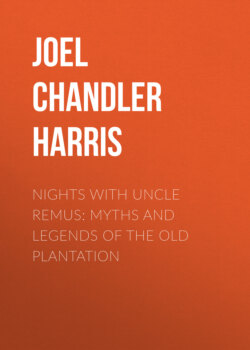Читать книгу Nights With Uncle Remus: Myths and Legends of the Old Plantation - Joel Chandler Harris - Страница 5
На сайте Литреса книга снята с продажи.
FOOTNOTES:
ОглавлениеTable of Contents
[i_1] Uncle Remus; His Songs and His Sayings. The Folk-Lore of the Old Plantation. New York: D. Appleton & Co. 1880.
[i_2] Amazonian Tortoise Myths, pp. 2, 3.
[i_3] Page 10.
[i_4] Kaffir Folk-Lore; or, A Selection from the Traditional Tales current among the People living on the Eastern Border of the Cape Colony. London, 1882.
[i_5] Kaffir Folk-Lore, p. 43.
[i_6] Professor Hartt, in his Amazonian Tortoise Myths, relates the story of "The Jabuti that Cheated the Man." The Jabuti is identical with Brother Terrapin. The man carried the Jabuti to his house, put him in a box, and went out. By and by the Jabuti began to sing, just as Brother Rabbit did. The man's children listened, and the Jabuti stopped. The children begged him to continue, but to this he replied: "If you are pleased with my singing, how much more would you be pleased if you could see me dance." The children thereupon took him from the box, and placed him in the middle of the floor, where he danced, to their great delight. Presently, the Jabuti made an excuse to go out, and fled. The children procured a stone, painted it like the tortoise, and placed it in the box. After a while the man returned, took the painted stone from the box and placed it on the fire, where it burst as soon as it became heated. Meantime, the Jabuti had taken refuge in a burrow having two openings, so that, while the man was looking in at one opening, the tortoise would appear at another. Professor Hartt identifies this as a sun-myth—the slow-sun (or tortoise) escaping from the swift-moon (or man).
[i_7] Kaffir Folk-Lore, p. 84.
[i_8] Page 89.
[i_9] Kaffir Folk-Lore, p. 178.
[i_10] Page 111.
[i_11] Kaffir Folk-Lore, p. 166.
[i_12] Uncle Remus: His Songs and Sayings, xix. p. 88.
[i_13] Amazonian Tortoise Myths, p. 29.
[i_14] Reynard, the Fox, in South Africa; or, Hottentot Fables and Tales. By W. H. I. Bleek, Ph. D. London, 1864.
[i_15] Page 32.
[i_16] Bleek, p. 23.
[i_17] O'Selvagem, p. 237. Quoted by Mr. Herbert H. Smith, in his work Brazil and the Amazons.
[i_18] Page 37.
[i_19] The first volume.
[i_20] D. G. Brinton's Myths, pp. 161–170.
[i_21] The American Journal of Philology, vol. iii. no. 11.
[i_22] Tchiak is the name given by the Creole negroes to the starling, which, Dr. Mercier tells me, is applied adjectively to express various states of spirituous exhilaration.—Note by Prof. Harrison.
